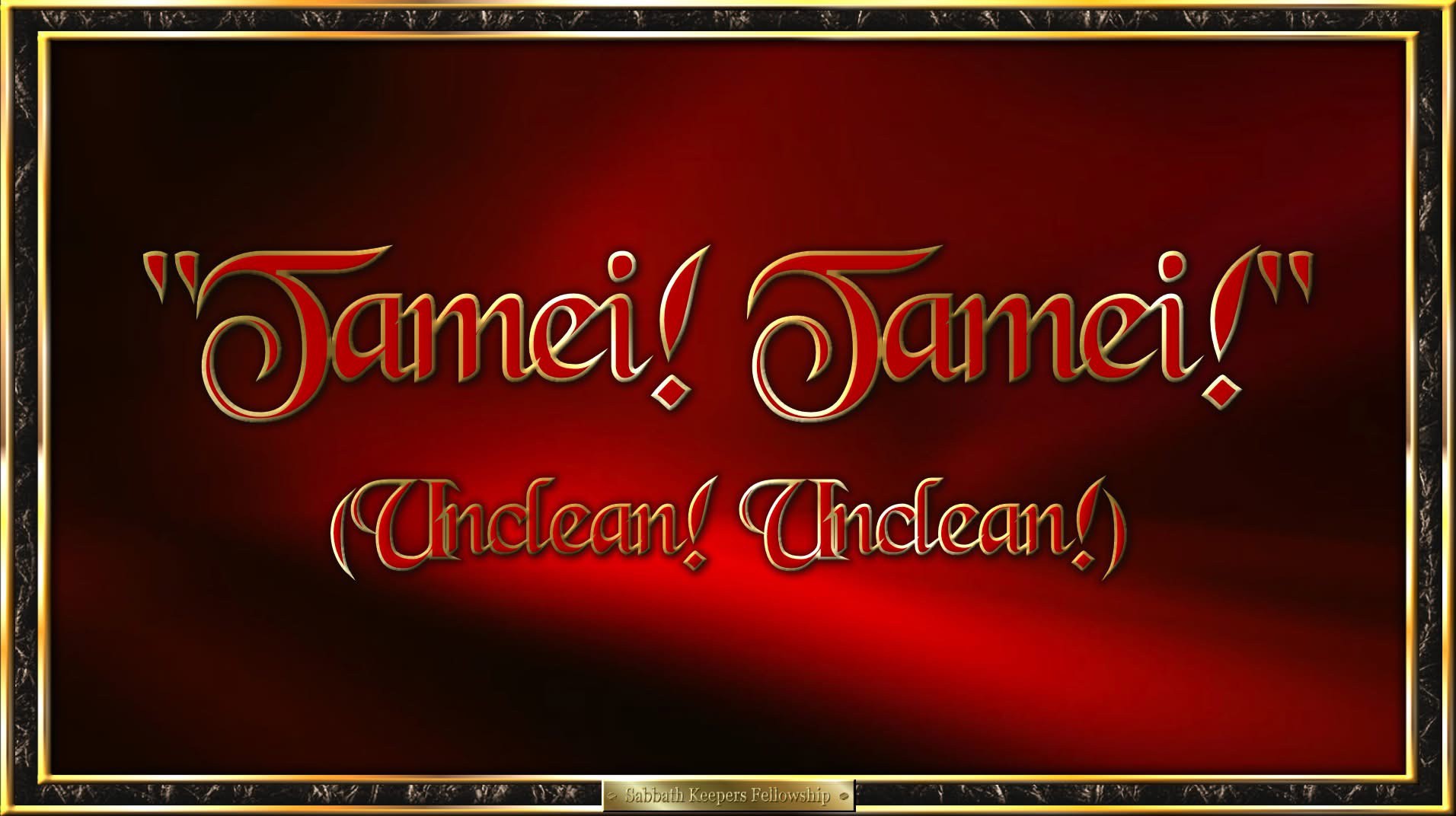Watch
Events
Articles
Market
More
FROM THIS WEEK’S TORAH PORTION – THAZRYA:
This week’s Torah portion, Thazria, deals with the subject of ritual purity and impurity, a very difficult spiritual concept for our modern minds to fully comprehend. Following the opening verses concerning the birth of a baby boy or girl and the mother’s subsequent period of purification, which concludes with the bringing of an offering to the Temple, the Torah focuses exclusively on the even more obscure issue of “tzara’at,” a particular type of affliction which causes the appearance of lesions upon one’s flesh, discoloration in one’s garments, or a mold-like discoloration of the stones of one’s house. What are we to make of this?
That tzara’at was a psychosomatic, or spiritual-somatic ailment is made clear by Torah’s assigning of the kohanim (priests) to both diagnose and prescribe the ritual cure for the outbreak of the malady, instead of a physician. The cure involved confession, repentance, immersion in pure, “living waters” and the bringing of an offering to the Temple once the symptoms had disappeared, after which the individual was again permitted to reenter fellowship in a state of purity.
While certain aspects concerning scriptural purity are still relevant to a modern believer’s lifestyle, the majority of the commandments concerning tzara’at are not currently physically applicable, by virtue of the fact that the Temple is currently not standing. Naturally, being deprived of the actual physical application of these laws of purity for two thousand years has made them much more foreign to our modern sensibilities, and are much more difficult to grasp intellectually and spiritually.
So, what does Torah intend by the terms tahara (purity) and tum’a (impurity)? Note that Torah never employs an equivalent of our modern qualifier “ritual” in discussing purity. The modern use of the word ritual in this context is merely an admission of a lack of true understanding. With a true Torah mindset, tahara and tum’a are two spiritual but very real and necessary realities unto themselves.
To put it simply, to be tahor, (in a state of tahara) is to be rightly connected to the life-giving force of the Creator. To be ta’mei, (in a state of tum’a) is to be defiled and disconnected from Elohim’s life-giving energy. The Temple at Jerusalem is the place on earth which YHWH has decreed to be of the highest level of purity. It is there where Elohim’s Presence, known as Shechinah, resides. It is the physical nexus between this world and the heavens, between YHWH and His people. That is why no one can physically enter into the inner Temple courtyards unless they have repented and have been sprinkled by the waters of the ashes of the red heifer, which render them cleansed of any impurity contracted through contact with death.
It is commonly believed that the plague of “tzara’at,” in scripture is the same as modern day leprosy and known as “Hansen’s Disease.” It is not. There are many differences. Hansen’s disease is a wasting disease that eats away the flesh. Tzara’at is somewhat more topical. Also, Hansen’s disease only affects humans, whereas tzara’at can also affect fabrics, hides, and even dwellings. Tzara’at is only found in the pages of scripture now, physically, and is no longer known to be extant in the world. The ancient Jewish sages speculate that this is because YHWH has, in His mercy, suspended the physical effects of this malady until such time that the Temple is once again rebuilt and functioning: With no Temple, there can be no inspection of an infected person by a kohein (priest), and no return to the community for those cured of the disease. This would be a very harsh and, for now, irreparable punishment, and so it is thought that, for a time, YHWH has temporarily suspended the disease from the world. It is easy to believe this is true, for there is not a trace of the disease left anywhere, even though it was once widespread, highly contagious, and no cure for it was ever found. While the physical effects of tzara’at may have been temporarily suspended, its essential cause, Lashon Hara (Evil Speech), is not.
Lashon Hara is speaking negatively of others, being careless, insensitive and hurtful in how we speak of our fellows, either to their faces or behind their backs, and regardless of whether such speech is true, or not. To speak ill of someone, Torah tells us, is a form of murder by diction – character assassination. In Temple times, the speaker of Lashon Hara would immediately come down with a case of tzara’at. His use of evil speech would be exposed and, shameful as that was, he or she would be afforded a path back to purity and rehabilitation. Today, it is much easier to get away with speaking ill of others, as there is no immediate outward penalty for it. However, with proper understanding of the scriptural precepts of Shemirath Halashon (Guarding the Tongue), this archaic, ancient, physically extinct affliction known as tzara’at can seem much less obscure and dubious. In fact, it should hopefully become obvious and horrendous before our eyes. With Spirit-led learning and application of its precepts, Shemirath Halashon should make apparent the power of language, the need to keep our sharp tongues sheathed, and to henceforth speak only life affirming words of positivity whenever possible.
Consider these examples from scripture:
In Parshath Sh’moth, Moshe spoke evil of the people of Yisrael by telling YHWH:
“But behold, they will not believe me, nor hearken unto my voice; for they will say: ‘YHWH hath not appeared unto thee.’”
In response, YHWH told Moshe:
“Put now thy hand into thy bosom.”
Then when Moshe took his hand back out,
“Behold, his hand was leprous – as white as snow.”
Again, in Parshath Beha’alotka, Miriam spoke out against Moshe’s choice of a Kushi woman for a wife. As punishment, YHWH reproved her on Moshe’s behalf and,
“Behold, Miriam was leprous, as white as snow.” She was then “shut up without the camp for seven days.”
In this and several other instances in scripture, the cause of tzara’at was Lashon Hara against one’s fellow. This terrible sin is absolutely rampant in the world now among the people of YHWH. And while the physical blemishes caused by it are no longer evident at this time, it still undoubtably leaves a horrible spiritual blemish behind it with every foul word spoken.
Even worse than the physical and spiritual blemishes incurred by Lashon Hara, is the judgment upon a person who is convicted of it:
“He shall dwell alone. Outside the community is his dwelling.”
It is similar to the sentence of karet, and there can be no punishment that is ultimately worse than such excision from the community. Karet is complete and indefinite exclusion from the people of Yisrael. The reason for such harsh judgment is because of the seriousness of the crime and its effects. Lashon Hara ruins or can even kill another person. In scripture it is equated with murder. It spreads contagiously like a disease, and the only remedy for it is to put those who are unrepentantly infected with it “out of the camp.”
Consider this: if the people who constitute the greater Commonwealth of Yisrael are the only people included in both the Old and New covenants and therefore eligible for everlasting life in the kingdom of YHWH, and if the punishment for Lashon Hara is tzara’at and excision from the community of Yisrael, then what is it worth to you to learn how to remove this sin from your life? This is one of the most abominable transgressions one can commit against another person, and so it is absolutely vital that you do. But, if you don’t believe my words and reasoning on this subject, then consider instead the many words of Shaul of Tarsus and the rest of Yehoshua’s talmidim (taught ones) on the subject of sins of the tongue. Go read and see for yourself how many times and in how many ways they speak out against improper use of the tongue and its terrible effects. Read and see how over and over they warned of and denounced this vile and wicked practice – this disease.
Consider also that Yehoshua himself exhorted his followers to “love thy neighbor as thyself,” and said this was the second greatest command in all of Torah. Lashon Hara is an act of pure hate, and not of love. Think: each time you gossip or speak evil words about your fellow, the command of YHWH according to Torah is that you should cover your mouth as a leper and follow those words with a cry of “Tamei! Tamei!” – “Unclean! Unclean!” – and at that moment, that is exactly how you look in His eyes.



